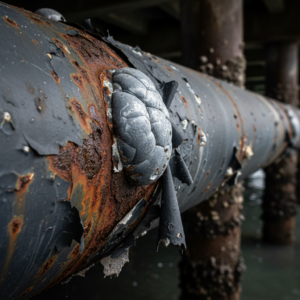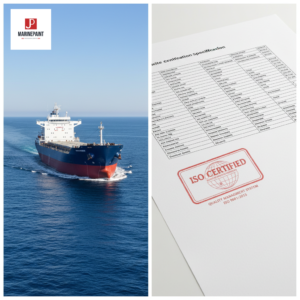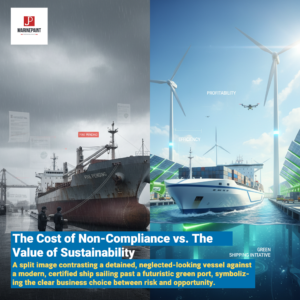What is the Best Antifouling Paint? An Ultimate Guide
Marine growth slowing your boat and burning fuel? Ignoring it can lead to costly hull damage. The right antifouling paint is your best defense against this constant underwater assault.
Antifouling paint, often called bottom paint, is a specialized coating applied to the underwater portion of a boat's hull to prevent the growth of marine organisms. This process, known as biofouling, involves barnacles, algae, slime, and weeds attaching to the hull. Without protection, this marine growth creates significant drag, which drastically reduces your vessel's speed and performance while increasing fuel consumption. Over time, it can even cause structural damage to the hull. Choosing the correct antifouling system is one of the most critical boat maintenance decisions you'll make. It not only saves on fuel costs but also protects your investment and contributes to a healthier marine environment by reducing carbon emissions [1]. This guide will walk you through everything from how these paints work to choosing the right type and applying it like a professional, ensuring your boat remains in peak condition.
![[Image Placeholder]> Prompt: A dramatic split-shot image showing the underwater part of a boat. One half of the hull is pristine and clean with a smooth coat of red antifouling paint. The other half is heavily covered in green algae, barnacles, and other marine growth. The water is clear blue, and the sun is shining above. [Image Placeholder]> Prompt: A dramatic split-shot image showing the underwater part of a boat. One half of the hull is pristine and clean with a smooth coat of red antifouling paint. The other half is heavily covered in green algae, barnacles, and other marine growth. The water is clear blue, and the sun is shining above.](https://jdmarinepaint.com/wp-content/uploads/2025/07/a-dramatic-split-shot-image-showing-the-underwater-2.png)
As technical consultants at JDmarine, we understand that a clean hull is the foundation of efficient and enjoyable boating. Let's dive into the world of antifouling paint to keep your vessel protected and performing at its best.
What is Antifouling Paint and Why is it Essential for Your Boat?
A clean hull seems simple, but underwater, your boat faces a constant battle. Tiny marine organisms are always looking for a surface to call home, and your boat's hull is prime real estate. This buildup, or biofouling, isn't just ugly; it creates drag, which can cripple your boat's performance, send your fuel bills soaring, and even cause long-term damage to the hull itself. Forgetting this crucial step in boat maintenance is an expensive mistake. Antifouling paint is the critical barrier that protects your investment, ensuring smooth sailing, fuel efficiency, and peace of mind. It’s an essential part of responsible boat ownership and aligns with environmental best practices for boaters.
At its core, antifouling paint (or bottom paint) is a specialized marine paint applied to the hull's submerged surfaces [12]. Its primary purpose is to deter marine life—like barnacles, weeds, and slime—from attaching to the hull [19]. The consequences of neglecting this protection are severe. A fouled hull can reduce a boat's speed by over 20% and increase fuel consumption by up to 40%. This not only costs you money but also increases your vessel's environmental footprint [1]. Furthermore, the organisms themselves can damage the hull's gelcoat or underlying materials, leading to expensive repairs. At JDmarine, we've seen firsthand how a well-maintained hull with a quality coating system, from primer to topcoat, preserves the value and integrity of a maritime asset. This guide will cover everything you need to know, from selection to application.

How Does Antifouling Paint Work its Magic Under the Waterline?
It seems like magic how a simple layer of paint can ward off an entire ecosystem of determined marine organisms. But if you don't understand the science behind it, you risk choosing an ineffective product, wasting a weekend on application, and ending up with a fouled hull anyway. The key is not magic, but chemistry. The secret lies in a controlled chemical process that makes your hull an inhospitable surface for fouling organisms, effectively creating a protective shield that keeps your hull clean and smooth season after season.
The primary mechanism behind most antifouling paint is the controlled release of active ingredients called biocides [3]. The most common and effective biocide used in recreational boat paints is cuprous oxide (氧化亚铜) [16][25]. This copper-based compound is toxic to the microscopic larvae of barnacles and other organisms. When the paint is submerged, it slowly leaches these biocides into the water just millimeters from the hull's surface. This creates a thin, toxic boundary layer that deters the organisms from attaching or kills them before they can get a firm grip. The paint is engineered to release these biocides at a steady, calculated rate throughout its service life, ensuring continuous protection for one or more seasons.
Decoding the Types of Antifouling Paint: Which is Best for You?
Walking into a marine supply store and facing a wall of bottom paint can be overwhelming. Hard, soft, ablative, biocide-free—the options seem endless. Choosing the wrong type of antifouling paint for your vessel and boating habits is a common and costly mistake. You could end up with a paint that requires laborious sanding every year, or one that wears away too quickly in high-current areas, leaving your hull vulnerable mid-season. Understanding the fundamental differences between the main types of antifouling is the key to making an informed decision that saves you time, money, and effort in the long run.
The best antifouling paint depends on your boat type, how you use it, and where you keep it. Generally, they fall into three categories: hard, soft (ablative/self-polishing), and biocide-free. Hard paints create a durable, scrubbable surface ideal for fast or racing boats. Soft, or ablative, paints wear away with the flow of water, constantly exposing fresh biocide, making them perfect for cruising boats as they eliminate paint buildup. Biocide-free coatings represent the future, offering a super-slick surface that fouling can't grip, though they work best on boats that are used frequently. Adhering to regulations like the International Convention on the Control of Harmful Anti-fouling Systems (AFS) is also crucial, as they govern the use of certain biocides.
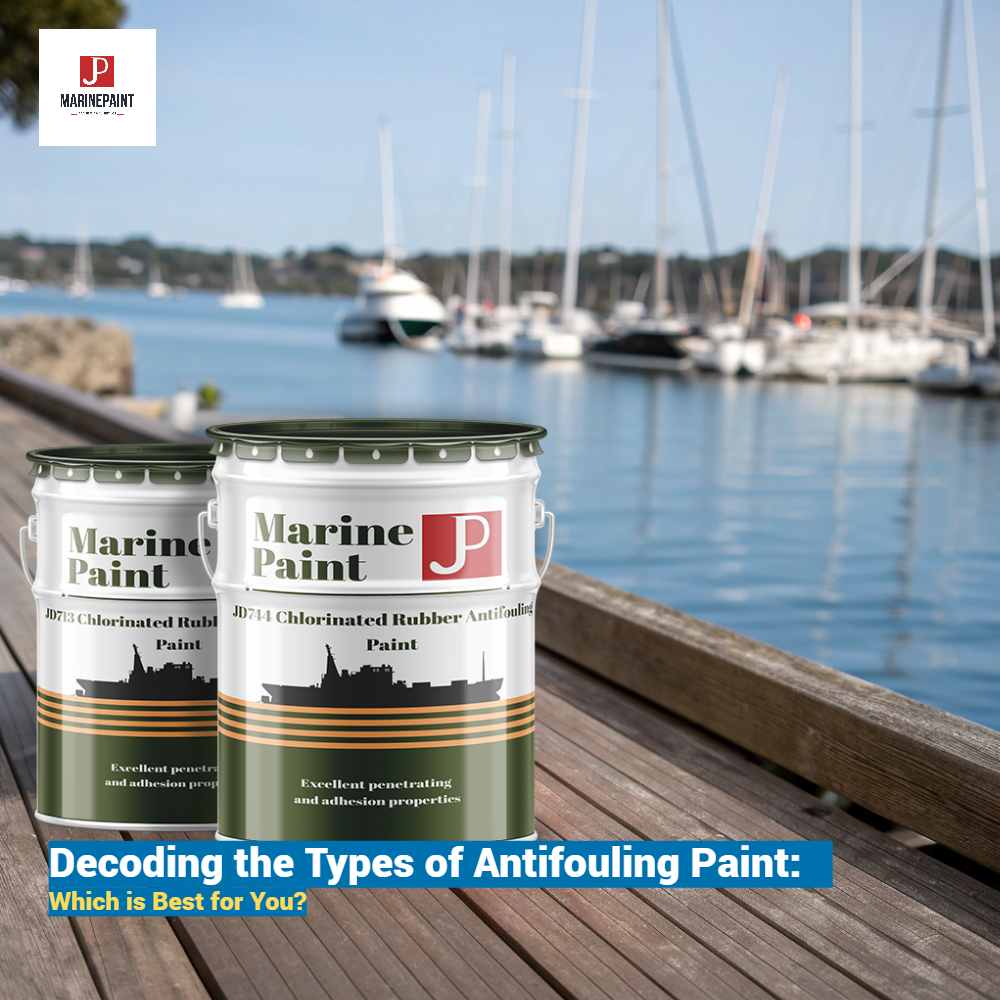
Hard Antifouling Paint (Modified Epoxy)
Hard antifouling paints, also known as contact leaching or modified epoxy paints, cure to a hard, porous finish. Biocides are packed into the pores and leach out upon contact with water. As the name implies, the finish is very durable and can be scrubbed and cleaned without removing a significant amount of paint. This makes it an excellent choice for fast powerboats, racing sailboats, or any boat that is regularly hauled and cleaned mid-season. The main drawback is that as the biocides leach out over time, the paint film remains, creating a dead, porous layer. This leads to paint buildup year after year, eventually requiring complete removal by heavy sanding.
Soft Antifouling Paint (Ablative / Self-Polishing)
Ablative or self-polishing paints are designed to wear away, or "ablate," with the friction of water flowing past the hull. This erosion constantly exposes a fresh layer of paint and biocide, ensuring consistent protection. This mechanism means there's no thick buildup of old paint, and preparation for the next season is as simple as a light wash and re-coating. For this reason, they are extremely popular with cruising sailboats and powerboats (typically under 30 knots). Products like our JD753 Tin-free self-polishing antifouling paint [7][16] are designed for long-lasting, reliable protection without the hassle of paint buildup. The downside is that they are not as durable against scrubbing and may wear faster on boats kept in high-current areas.
Biocide-Free & Silicone-Based Coatings (Fouling-Release)
Representing the eco-friendly future of hull protection, biocide-free coatings do not release toxins. Instead, they create an ultra-slick, low-friction surface that marine organisms simply cannot grip. Any light fouling that does manage to attach is typically washed off as soon as the boat moves through the water. These silicone or fluoropolymer-based paints are ideal for environmentally sensitive areas and for high-performance boats where a hydrodynamically smooth surface is a top priority. However, their effectiveness often depends on the boat being used regularly; they can be less effective on stationary vessels. Application is also more specialized and may require stripping the hull down to the gelcoat.
| Paint Type | How it Works | Best For | Pros | Cons |
|---|---|---|---|---|
| Hard Antifouling | Porous film slowly leaches biocides. | Fast boats, racing yachts, boats that are scrubbed. | Durable, scrubbable finish; multi-season protection. | Paint builds up over time; requires eventual sanding/stripping. |
| Soft (Ablative) | Erodes over time, constantly exposing fresh biocide. | Cruising sailboats, most powerboats. | No paint buildup; easy re-application; effective as long as paint is present. | Not as durable to scrubbing; may wear faster in high-wear areas. |
| Biocide-Free | Creates a super-slick surface organisms can't grip. | Performance boats, environmentally sensitive areas. | Non-toxic, improves fuel efficiency. | Less effective on stationary boats; requires specific application; can be more expensive. |
How Can You Apply Antifouling Paint Like a Pro?
Applying antifouling paint seems like a straightforward DIY job, but it's a process with many potential pitfalls. A poorly prepared surface, an incompatible primer, or incorrect application techniques can cause the paint to fail and peel off within weeks. This wastes all your time and money and, more importantly, leaves your boat's hull completely unprotected from aggressive marine growth. Furthermore, these paints contain biocides and solvents that are toxic, so handling them without the proper safety gear is a serious health risk [11]. By following a systematic, professional approach—from safety and prep to the final coat—you can achieve a durable, effective finish that lasts the entire season.
The key to a successful antifouling paint job lies in meticulous preparation and adherence to the manufacturer's instructions [5]. The process can be broken down into four main stages: ensuring safety with the right Personal Protective Equipment (PPE), preparing the hull surface, masking and priming for compatibility, and finally, the application itself. Skipping or rushing any of these steps is a recipe for failure. Whether you're working on a brand-new boat or applying a fresh coat over old paint, taking the time to do it right will pay dividends in performance and protection. Remember to always work in a well-ventilated area and on a dry day [14].
Safety First: Essential Personal Protective Equipment (PPE)
Antifouling paints are toxic by design. They contain biocides and solvents that can be harmful if inhaled, ingested, or absorbed through the skin [11]. When sanding old paint, you are also releasing these toxic dust particles into the air. Always wear the following PPE:
- Respirator: A respirator with organic vapor cartridges is essential to protect your lungs from solvent fumes and toxic dust.
- Goggles: Protect your eyes from splashes and dust.
- Gloves: Use solvent-resistant gloves (e.g., nitrile) to prevent skin contact.
- Coveralls: Disposable coveralls will protect your skin and clothing.
Step 1: Hull Surface Preparation
Proper surface preparation is the most critical factor for paint adhesion and durability [14]. The steps vary depending on the hull's condition.
- For New Boats: New hulls have a wax release agent from the mold that must be removed [9]. Use a de-waxing solvent and then lightly sand the entire surface to create a "key" for the primer to grip.
- For Previously Painted Boats: Start with a high-pressure wash to remove marine growth and loose paint [6][19]. Then, use a scraper to remove any flaking or blistering areas. The goal is a clean, dry, and sound surface, free of any oil, grease, or salt [27].
Step 2: Masking and Priming
Before painting, use high-quality painter's tape to mask off the waterline, anodes, transducers, and any other underwater hardware that shouldn't be painted [30]. Priming is the next crucial step.
- On a New or Bare Hull: You must apply a suitable epoxy primer, such as JDH819 Epoxy Zinc Phosphate Primer, to create a strong bond between the hull and the antifouling paint and to act as a barrier coat.
- Over Existing Paint: If the old paint is in good condition but you're unsure of the type or its compatibility with your new paint, it's safest to apply a tie-coat primer. A product like our JDH263 Epoxy Tie Coat [15] is designed to bond different layers together, preventing lifting or peeling.
Step 3: The Antifouling Paint Application
First, stir the paint thoroughly with a mechanical mixer if possible, as the heavy copper biocides settle at the bottom of the can [14]. Apply the paint using a solvent-resistant roller or brush. Maintain a wet edge to avoid lap marks. It's critical to apply the paint to the manufacturer's recommended film thickness to ensure it lasts the full season [8]. Apply an extra coat to high-wear areas like the waterline, keel, rudder, and bow thruster tunnel.
Step 4: Drying and Launching
Consult the paint can for the manufacturer's specific drying times [23]. These times are affected by temperature and humidity. There will be a minimum time before you can apply a second coat and a minimum time before you can launch the boat. There is also usually a maximum time to launch, after which the paint's effectiveness can diminish. Rushing the launch can ruin your hard work, so be patient and follow the guidelines precisely.
How Do You Maintain and Remove Your Antifouling Paint?
The job isn't over once the paint is on and the boat is launched. Antifouling paint is a consumable product with a finite lifespan, and its maintenance is a key part of the annual boating cycle. Letting the paint wear out completely re-exposes your hull to aggressive marine growth, undoing all the benefits. Conversely, allowing old, hard antifouling layers to build up season after season creates a thick, unstable surface that adds weight and can eventually start to flake off in sheets. This buildup will eventually need to be removed—a difficult and messy job if left for too long. A regular maintenance schedule and knowing the proper removal techniques will save you major headaches and ensure continuous protection for your vessel.
Most boat owners reapply antifouling paint annually, but the exact lifespan depends on the paint type, the number of coats applied, water conditions, and how often the boat is used. An ablative paint might last one or two seasons, while a hard epoxy with multiple coats could last longer. The time to reapply is when you notice the old coat is visibly thin or when you start to see slime or other growth appearing more quickly than usual. When the time comes to remove old paint buildup, there are several methods. Wet sanding is preferred to dry sanding as it minimizes airborne toxic dust. Dedicated paint scrapers, especially those with vacuum attachments, are effective for thick layers. For a complete removal, chemical strippers designed for marine use can be used, but you must choose one that is safe for your hull material (e.g., fiberglass). Responsible disposal of all paint chips and waste is a legal and environmental necessity.
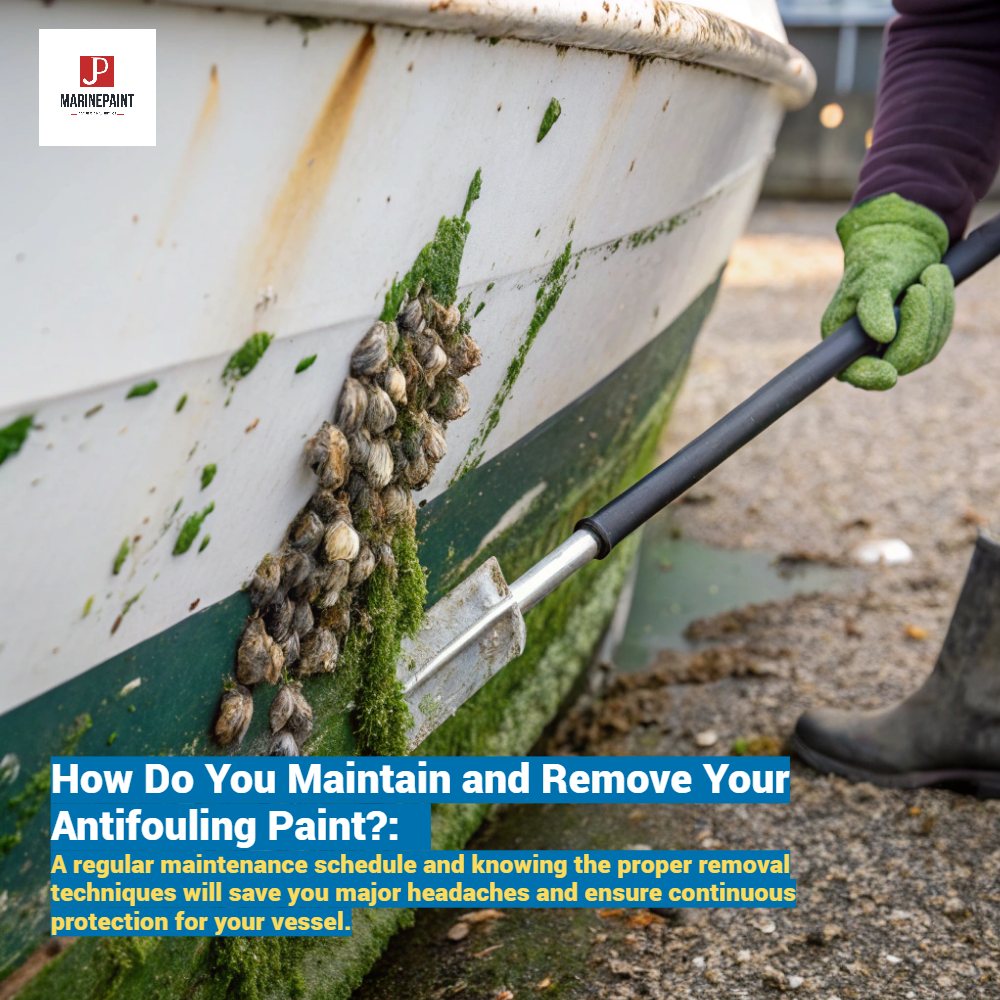
Have Questions About Antifouling Paint? We Have Answers.
Even after covering the basics, specific questions always pop up when it comes to the practical side of boat maintenance. Uncertainty about things like paint compatibility, reapplication times, or the necessity of a primer can lead to confusion, costly mistakes, or unnecessary work. You need clear, straightforward answers you can trust to get the job done right. As technical consultants at JDmarine, we field these questions every day from boat owners just like you. To help, we've compiled the answers to some of the most frequently asked questions about antifouling paint.
Here are quick answers to the top questions we receive:
-
What is the difference between hard and soft antifouling paint?
Hard antifouling dries to a durable, scrubbable finish that doesn't wear away, but it builds up over time. Soft (ablative) antifouling erodes with water flow, constantly exposing fresh biocide and eliminating paint buildup, but it's less resistant to scrubbing. -
How often should you antifoul a boat?
Generally, it's an annual task. However, this depends heavily on the paint type, usage, and local fouling conditions. Some high-quality, multi-season paints can last longer if applied correctly. -
Can you paint new antifouling over old?
Yes, provided the old paint is in good, sound condition (not flaking) and is compatible. If you're applying a soft paint over an old hard paint, the hard paint must be sanded first. If the old paint type is unknown, it's best to use a tie-coat primer like JDH263 Epoxy Tie Coat to ensure adhesion [15]. -
Do you need to prime before antifouling?
On a new boat or a hull stripped to its bare surface, a primer is absolutely essential for adhesion and barrier protection [9]. Over existing, compatible antifouling that is in good condition, a primer is not usually necessary. -
How long after painting can a boat be put in the water?
This varies significantly between products. Always check the manufacturer's technical data sheet. Typically, launch times range from 12 to 24 hours after the final coat is applied, but some paints have wider or narrower windows [23].
Conclusion
A well-maintained hull is invaluable, directly impacting your boat's performance, fuel economy, and structural integrity. Choosing and correctly applying the right antifouling paint is a critical investment in your vessel.
![]()


